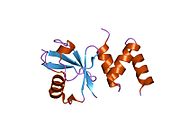Biology:CBLB (gene)
From HandWiki
 Generic protein structure example |
CBL-B is an E3 ubiquitin-protein ligase that in humans is encoded by the CBLB gene.[1][2] CBLB is a member of the CBL gene family.
Function
CBL-B functions as a negative regulator of T-cell activation.[3] CBL-B expression in T cells causes ligand-induced T cell receptor down-modulation, controlling the activation degree of T cells during antigen presentation.[4][5]
Clinical significance
Mutation of the CBLB gene has been associated with autoimmune conditions such as type 1 diabetes.[6][7]
Interactions
CBLB has been shown to interact with:
- CRKL,[8]
- Epidermal growth factor receptor,[9][10]
- Grb2,[8][11]
- NEDD4,[12]
- PIK3R1,[8][11] and
- SH3KBP1.[13]
References
- ↑ "Cloning and characterization of cbl-b: a SH3 binding protein with homology to the c-cbl proto-oncogene". Oncogene 10 (12): 2367–77. July 1995. PMID 7784085.
- ↑ "Entrez Gene: CBLB Cas-Br-M (murine) ecotropic retroviral transforming sequence b". https://www.ncbi.nlm.nih.gov/sites/entrez?Db=gene&Cmd=ShowDetailView&TermToSearch=868.
- ↑ "Releasing the brake: targeting Cbl-b to enhance lymphocyte effector functions". Clin. Dev. Immunol. 2012: 692639. 2012. doi:10.1155/2012/692639. PMID 22550535.
- ↑ "Pc-Cbl and Cbl-b regulate T cell responsiveness by promoting ligand-induced TCR down-modulation.". Nature Immunology 3 (12): 1192–9. August 2002. doi:10.1038/ni855. PMID 12415267.
- ↑ "PD-L1 co-stimulation contributes to ligand-induced T cell receptor down-modulation on CD8+ T cells". EMBO Molecular Medicine 3 (10): 581–92. August 2011. doi:10.1002/emmm.201100165. PMID 21739608.
- ↑ "Visualizing the role of Cbl-b in control of islet-reactive CD4 T cells and susceptibility to type 1 diabetes". J. Immunol. 186 (4): 2024–32. February 2011. doi:10.4049/jimmunol.1002296. PMID 21248249.
- ↑ "Identification and functional analysis of CBLB mutations in type 1 diabetes". Biochem. Biophys. Res. Commun. 368 (1): 37–42. March 2008. doi:10.1016/j.bbrc.2008.01.032. PMID 18201552.
- ↑ 8.0 8.1 8.2 "Tyrosine phosphorylation and complex formation of Cbl-b upon T cell receptor stimulation". Oncogene 18 (5): 1147–56. February 1999. doi:10.1038/sj.onc.1202411. PMID 10022120.
- ↑ "Phosphotyrosine interactome of the ErbB-receptor kinase family". Mol. Syst. Biol. 1: E1–E13. 2005. doi:10.1038/msb4100012. PMID 16729043.
- ↑ "cbl-b inhibits epidermal growth factor receptor signaling". Oncogene 18 (10): 1855–66. March 1999. doi:10.1038/sj.onc.1202499. PMID 10086340.
- ↑ 11.0 11.1 "The CBL-related protein CBLB participates in FLT3 and interleukin-7 receptor signal transduction in pro-B cells". J. Biol. Chem. 273 (24): 14962–7. June 1998. doi:10.1074/jbc.273.24.14962. PMID 9614102.
- ↑ "WW domain HECT E3s target Cbl RING finger E3s for proteasomal degradation". J. Biol. Chem. 278 (44): 43169–77. October 2003. doi:10.1074/jbc.M308009200. PMID 12907674.
- ↑ "CIN85 participates in Cbl-b-mediated down-regulation of receptor tyrosine kinases". J. Biol. Chem. 277 (42): 39666–72. October 2002. doi:10.1074/jbc.M205535200. PMID 12177062.
External links
- Human CBLB genome location and CBLB gene details page in the UCSC Genome Browser.
Further reading
- "Regulation of immune responses by E3 ubiquitin-protein ligases". Signal Transduction Pathways in Autoimmunity. Current Directions in Autoimmunity. 5. 2002. pp. 161–75. doi:10.1159/000060552. ISBN 3-8055-7308-1.
- "Neuroblastoma oligo-capping cDNA project: toward the understanding of the genesis and biology of neuroblastoma". Cancer Lett. 197 (1–2): 63–8. 2003. doi:10.1016/S0304-3835(03)00085-5. PMID 12880961.
- "Normalization and subtraction: two approaches to facilitate gene discovery". Genome Res. 6 (9): 791–806. 1997. doi:10.1101/gr.6.9.791. PMID 8889548.
- "Cbl-b, a member of the Sli-1/c-Cbl protein family, inhibits Vav-mediated c-Jun N-terminal kinase activation". Oncogene 15 (21): 2511–20. 1997. doi:10.1038/sj.onc.1201430. PMID 9399639.
- "The CBL-related protein CBLB participates in FLT3 and interleukin-7 receptor signal transduction in pro-B cells". J. Biol. Chem. 273 (24): 14962–7. 1998. doi:10.1074/jbc.273.24.14962. PMID 9614102.
- "Tyrosine phosphorylation and complex formation of Cbl-b upon T cell receptor stimulation". Oncogene 18 (5): 1147–56. 1999. doi:10.1038/sj.onc.1202411. PMID 10022120.
- "A direct interaction between the adaptor protein Cbl-b and the kinase zap-70 induces a positive signal in T cells". Curr. Biol. 9 (4): 203–6. 1999. doi:10.1016/S0960-9822(99)80090-6. PMID 10074432.
- "cbl-b inhibits epidermal growth factor receptor signaling". Oncogene 18 (10): 1855–66. 1999. doi:10.1038/sj.onc.1202499. PMID 10086340.
- "Evidence for direct interaction between Sprouty and Cbl". J. Biol. Chem. 276 (8): 5866–75. 2001. doi:10.1074/jbc.M006945200. PMID 11053437.
- "Cbl-b, a RING-type E3 ubiquitin ligase, targets phosphatidylinositol 3-kinase for ubiquitination in T cells". J. Biol. Chem. 276 (7): 4872–8. 2001. doi:10.1074/jbc.M008901200. PMID 11087752.
- "Cbl-b-dependent coordinated degradation of the epidermal growth factor receptor signaling complex". J. Biol. Chem. 276 (29): 27677–84. 2001. doi:10.1074/jbc.M102641200. PMID 11375397.
- "A positive regulatory role for Cbl family proteins in tumor necrosis factor-related activation-induced cytokine (trance) and CD40L-mediated Akt activation". J. Biol. Chem. 276 (32): 30011–7. 2001. doi:10.1074/jbc.M100414200. PMID 11406619.
- "Proteolysis-independent regulation of PI3K by Cbl-b-mediated ubiquitination in T cells". Nat. Immunol. 2 (9): 870–5. 2001. doi:10.1038/ni0901-870. PMID 11526404.
- "Differential expression and signaling of CBL and CBL-B in BCR/ABL transformed cells". Oncogene 21 (9): 1423–33. 2002. doi:10.1038/sj.onc.1205202. PMID 11857085.
- "Cbl-b positively regulates Btk-mediated activation of phospholipase C-gamma2 in B cells". J. Exp. Med. 196 (1): 51–63. 2002. doi:10.1084/jem.20020068. PMID 12093870.
- "CIN85 participates in Cbl-b-mediated down-regulation of receptor tyrosine kinases". J. Biol. Chem. 277 (42): 39666–72. 2002. doi:10.1074/jbc.M205535200. PMID 12177062.
- "Cbl-directed monoubiquitination of CIN85 is involved in regulation of ligand-induced degradation of EGF receptors". Proc. Natl. Acad. Sci. U.S.A. 99 (19): 12191–6. 2002. doi:10.1073/pnas.192462299. PMID 12218189. Bibcode: 2002PNAS...9912191H.
- "Generation and initial analysis of more than 15,000 full-length human and mouse cDNA sequences". Proc. Natl. Acad. Sci. U.S.A. 99 (26): 16899–903. 2003. doi:10.1073/pnas.242603899. PMID 12477932. Bibcode: 2002PNAS...9916899M.



